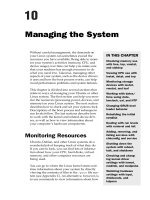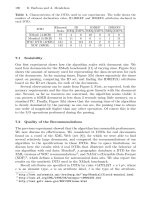Oracle Database 10g: Managing the Self-Managing Database Certified Oracle 10g Technician ppt
Bạn đang xem bản rút gọn của tài liệu. Xem và tải ngay bản đầy đủ của tài liệu tại đây (3.56 MB, 98 trang )
Oracle Database 10
g
:
Managing the Self-
Managing Database
Certified Oracle 10g Technician
How DBAs Spend Their Time?
Install
6%
Maintain
Software
6%
Create &
Configure
12%
Load Data
6%
System
Management
55%
Install
6%
Maintain
Software
6%
Create &
Configure
12%
Load Data
6%
System
Management
55%
How DBAs Spend Their Time?
Software Installation
• Fast lightweight install
– Major redesign of installation process
– Single CD, 20 Minutes
– CPU, memory, disk space consumption greatly reduced
– Extremely lightweight client install (3 files) using Oracle Instant
Client
• Automation of All Pre and Post Install Steps
– Validate OS Configuration, patches, resource availability etc.
– Configure all components (listeners, database, agent, OMS,
OID etc.) for automatic startup and shutdown
• Enhanced silent install
Simplified Creation &
Configuration
• Greatly reduced database creation time using
pre-configured, ready-to-use database
• 90% reduction of initialization parameters: < 30
Basic parameters
• Automatically setup common tasks, e.g. backups
• Automatically configures LDAP server
• Automatic Shared Server Set-up
• Easy Connect Naming
Basic Parameters
y compatible
y processes
y sessions
y pga_aggregate_target
y nls_language
y nls_territory
y db_domain
y shared_servers
y instance_number
y cluster_database
y db_block_size
y sga_target
y control_files
y db_name
y db_recovery_file_dest
y remote_listener
y db_recovery_file_dest_size
y db_create_online_log_dest_n
y db_create_file_dest
y log_archive_dest_n
y log_archive_dest_state_n
y remote_login_passwordfile
y db_unique_name
Simplified Upgrade
• Pre upgrade checks (e.g. parameter settings)
• Post upgrade status checks
• Time estimator
• Re-startable
• Guide administrators in using best practices
Out-of-the-Box Database
Control
• No separate install
• Fully functional
administration and
monitoring after database
creation
• Listener discovery,
configuration & monitoring
Install
6%
Maintain
Software
6%
Create &
Configure
12%
Load Data
6%
System
Management
55%
How DBAs Spend Their Time?
Data Pump: What is it?
• Server-based facility for high performance
loading and unloading of data and metadata
• Callable: DBMS_DATAPUMP. Internally uses
DBMS_METADATA
• Data written in Direct Path stream format. Metadata
written as XML
• New clients expdp and impdp: Supersets of original
exp / imp.
• Foundation for Streams, Logical Standby, Grid,
Transportable Tablespaces and Data Mining initial
instantiation.
Features: Performance!!
• Automatic, two-level parallelism
– Direct Path for inter-partition parallelism
– External Tables for intra-partition parallelism
– Simple: parallel=<number of active threads>
– Dynamic: Workers can be added and removed from a running
job in Enterprise Edition
– Index builds automatically “parallelized” up to degree of job
• Simultaneous data and metadata unload
• Single thread of data unload: 1.5-2X exp
• Single thread of data load: 15X-40X imp
• With index builds: 4-10X imp
Features: Checkpoint / Restart
• Job progress recorded in a “Master Table”
• May be explicitly stopped and restarted later:
– Stop after current item finishes or stop immediate
• Abnormally terminated job is also restartable
• Current objects can be skipped on restart if
problematic
Features: Monitoring
• Flexible GET_STATUS call
• Per-worker status showing current object and
percent done
• Initial job space estimate and overall percent done
• Job state and description
• Work-in-progress and errors
Features: Network Mode
• Network import: Load one database
directly from another
• Network export: Unload a remote database to a local
dumpfile set
– Allows export of read-only databases
• Data Pump runs locally, Metadata API runs remotely.
• Uses DB links / listener service names, not pipes. Data
is moved as ‘insert into <local table> select from <remote
table>@service_name’
• Direct path engine is used on both ends
• It’s easy to swamp network bandwidth: Be careful!
Features: Fine-Grained Object Selection
• All object types are supported for both operations:
export and import
• Exclude: Specified object types are excluded from the
operation
• Include: Only
the specified object types are included.
E.g, just retrieve packages, functions and procedures
• More than one of each can be specified, but use of both
is prohibited by new clients
• Both take an optional name filter for even finer
granularity:
– INCLUDE PACKAGE: “LIKE ‘PAYROLL%’ “
– EXCLUDE TABLE: “IN (‘FOO’,’BAR’, … )’ “
New Clients – expdp / impdp
• Similar (but not identical) look and feel to exp / imp
• All modes supported: full, schema, table, tablespace,
transportable. Superset of exp / imp
• Flashback is supported
• Query supported by both expdp and impdp… and on a
per-table basis!
• Detach from and attach to running jobs
• Multiple clients per job allowed; but a single client can
attach to only one job at a time
• If privileged, attach to and control other users’ jobs
New Clients – expdp / impdp
• Interactive mode entered via Ctl-C:
– ADD_FILE: Add dump files and wildcard specs. to job
– PARALLEL: Dynamically add or remove workers
– STATUS: Get detailed per-worker status and change reporting
interval
– STOP_JOB{=IMMEDIATE}: Stop job, leaving it restartable.
Immediate doesn’t wait for workers to finish current work
items… they’ll be re-done at restart
– START_JOB: Restart a previously stopped job
– KILL_JOB: Stop job and delete all its resources (master table,
dump files) leaving it unrestartable
– CONTINUE: Leave interactive mode, continue logging
– EXIT: Exit client, leave job running
Features: Other Cool Stuff…
• Can extract and load just data, just metadata or both
• SQLFILE operation generates executable DDL script
• If a table pre-exists at load time, you can: skip it
(default), replace it, truncate then load or append to it.
• Space estimates based on allocated blocks (default) or
statistics if available
• Enterprise Manager interface integrates 9i and 10g
• Callable!
Large Internet Company
2 Fact Tables: 16.2M rows, 2 Gb
Program Elapsed
exp out of the box: direct=y 0 hr 10 min 40 sec
exp tuned: direct=y buffer=2M recordlength=64K 0 hr 04 min 08 sec
expdp out of the box: Parallel=1 0 hr 03 min 12 sec
imp out of the box 2 hr 26 min 10 sec
imp tuned: buffer=2M recordlength=64K 2 hr 18 min 37 sec
impdp out of the box: Parallel=1 0 hr 03 min 05 sec
Keep in Mind:
• Designed for *big* jobs with lots of data.
– Metadata performance is about the same
– More complex infrastructure, longer startup
• XML is bigger than DDL, but much more flexible
• Data format in dump files is ~15% more
compact than exp
• Import subsetting is accomplished by pruning
the Master Table
Original exp and imp
• Original imp will be supported
forever to allow loading of V5 – V9i dump files
• Original exp will ship at least in 10
g, but may
not support all new functionality.
•9i exp may be used for downgrades from 10
g
• Original and Data Pump dump file formats are
not compatible
Install
6%
Maintain
Software
6%
Create &
Configure
12%
Load Data
6%
System
Management
55%
How DBAs Spend Their Time?
Database Management Challenges
Application
and SQL
Management
Storage
Management
Backup and
Recovery
Management
System
Resource
Management
Space
Management
?
?
?
?
?
Solution: Self-Managing Database
Application
and SQL
Management
Storage
Management
Backup and
Recovery
Management
System
Resource
Management
Space
Management
Fix Advise
AlertMonitor
Common
Manageability
Infrastructure
Automatic
Management
Enterprise
Manager
Database
Console
Common Manageability Infrastructure:
Automatic Workload Repository
Automatic
Workload
Repository
Server
Alerts
Automated
Tasks
Advisory
Framework
Data Warehouse
of the Database
Automatic collection
of important statistics
Direct memory
access
Automatic Proactive
Efficient









